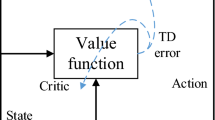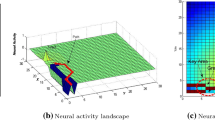Abstract
In this paper, we focus on the utilisation of reactive trajectory imitation controllers for goal-directed visual navigation in mobile robotics. We propose topological navigation graph (TNG) framework. TNG is an imitation-learning-based topological navigation framework for navigating through environments with intersecting trajectories. It represents the environment as a directed graph composed of perception and action modules. Each vertex of the graph corresponds to a trajectory and is represented by a trajectory identification classifier and a trajectory imitation controller. The edges of TNG correspond to intersections between trajectories and are represented by trajectory intersection recognition classifiers. Having a visually specified goal state, TNG navigates by forming a sequential composition plan of trajectory imitation controllers. We also propose to apply neural object detection architectures for the task of trajectory following by detecting direction of movement. We provide empirical evaluation of the proposed navigation framework and its components both in simulated and real-world environments and demonstrate that TNG allows us to utilise non-goal-directed, imitation-learning methods for goal-directed autonomous navigation.
Graphic abstract















Similar content being viewed by others
References
Aström, K. J., & Murray, R. M. (2010). Feedback systems: An introduction for scientists and engineers. Princeton: Princeton University Press.
Bansal, M., Krizhevsky, A., & Ogale, A. S. (2018). Chauffeurnet: Learning to drive by imitating the best and synthesizing the worst. arXiv:1812.03079.
Bewley, A., Rigley, J., Liu, Y., Hawke, J., Shen, R., Lam, V.-D., et al. (2019). Learning to drive from simulation without real world labels. In ICRA.
Bojarski, M., Testa, D. D., Dworakowski, D., Firner, B., Flepp, B., Goyal, P., et al. (2016). End to end learning for self-driving cars. In CoRR. arXiv:1604.07316.
Bruce, J., Sünderhauf, N., Mirowski, P. W., Hadsell, R., & Milford, M. (2018). Learning deployable navigation policies at kilometer scale from a single traversal. In CoRL (pp. 346–361).
Burridge, R. R., Rizzi, A. A., & Koditschek, D. E. (1999). Sequential composition of dynamically dexterous robot behaviors. The International Journal of Robotics Research, 18(6), 534–555.
Calero, C. I., Shalom, D. E., Spelke, E. S., & Sigman, M. (2019). Language, gesture, and judgment: Children’s paths to abstract geometry. Journal of Experimental Child Psychology, 177, 70–85.
Calonder, M., Lepetit, V., Strecha, C., & Fua, P. (2010). Brief: Binary robust independent elementary features. In Computer vision ECCV (pp. 778–792). Springer.
Codevilla, F., López, A., Koltun, V., & Dosovitskiy, A. (2018a). On offline evaluation of vision-based driving models. In ECCV (Vol. 15, pp. 246–262).
Codevilla, F., Miiller, M., López, A., Koltun, V., & Dosovitskiy, A. (2018b). End-to-end driving via conditional imitation learning. In ICRA (pp. 1–9). IEEE.
Conner, D. C. (2008). Integrating planning and control for constrained dynamical systems. PhD thesis, Carnegie Mellon University, Pittsburgh, PA.
Deng, J., Dong, W., Socher, R., Li, L.-J., Li, K., & Fei-Fei, L. (2009). Imagenet: A large-scale hierarchical image database. In Proceedings of the IEEE Computer Society conference on computer vision and pattern recognition (pp. 248–255). IEEE.
Engel, J., & Cremers, D. (2014). Lsd-slam: Large-scale direct monocular slam. In ECCV (pp. 834–849).
Fraundorfer, F., Engels, C., & Nistér, D. (2007). Topological mapping, localization and navigation using image collections. In IROS (pp. 3872–3877).
Friedman, J., Hastie, T., & Tibshirani, R. (2001). The elements of statistical learning, volume 1. Springer series in statistics. New York.
Gaussier, P., & Zrehen, S. (1995). Perac: A neural architecture to control artificial animals. Robotics and Autonomous Systems, 16, 291–320.
Gershman, S. J., Horvitz, E. J., & Tenenbaum, J. B. (2015). Computational rationality: A converging paradigm for intelligence in brains, minds, and machines. Science, 349(6245), 273–278.
Glasmachers, T. (2017). Limits of end-to-end learning. In JMLR (Vol. 77, pp. 17–32).
Gupta, S., Davidson, J., Levine, S., Sukthankar, R., & Malik, J. (2017). Cognitive mapping and planning for visual navigation. In Proceedings of the IEEE Computer Society conference on computer vision and pattern recognition (pp. 7272–7281).
He, K., Zhang, X., Ren, S., & Sun, J. (2016). Deep residual learning for image recognition. In Proceedings of the IEEE Computer Society conference on computer vision and pattern recognition (pp. 770–778).
Ho, J., & Ermon, S. (2016). Generative adversarial imitation learning. In CoRR. arXiv:1606.03476.
Hussein, A., Elyan, E., Gaber, M. M., & Jayne, C. (2018). Deep imitation learning for 3d navigation tasks. Neural Computing and Applications, 29(7), 389–404.
Ikeda, T., Fukaya, M., & Mita, T. (2001). Position and attitude control of an underwater vehicle using variable constraint control. In Proceedings of the 40th IEEE conference on decision and control (Cat. No.01CH37228) (Vol. 4, pp. 3758–3763).
Kallem, V., Komoroski, A. T., & Kumar, V. (2011). Sequential composition for navigating a nonholonomic cart in the presence of obstacles. IEEE Transactions on Robotics, 27(6), 1152–1159.
Kantor, G., & Rizzi, A. A. (2005). Feedback control of underactuated systems via sequential composition: Visually guided control of a unicycle. In Robotics research. The eleventh international symposium (pp. 281–290). Springer.
Kingma, D. P., & Ba, J. (2014). Adam: A method for stochastic optimization. In ICLR.
Kuefler, A., Morton, J., Wheeler, T., & Kochenderfer, M. (2017). Imitating driver behavior with generative adversarial networks. In IV (pp. 204–211).
Labbé, M. (2011). Find-object. Retrieved from January 24, 2021, http://introlab.github.io/find-object.
LaValle, S. M. (2006). Planning algorithms. New York: Cambridge University Press.
Lin, T.-Y., Maire, M., Belongie, S., Hays, J., Perona, P., Ramanan, D., et al. (2014). Microsoft coco: Common objects in context. In Computer vision ECCV (pp. 740–755). Springer.
Liu, W., Anguelov, D., Erhan, D., Szegedy, C., Reed, S., Fu, C.-Y., et al. (2016). Ssd: Single shot multibox detector. In European conference on computer vision (pp. 21–37). Springer.
Milford, M. J., & Wyeth, G. F. (2008). Mapping a suburb with a single camera using a biologically inspired slam system. IEEE Transactions on Robotics, 24(5), 1038–1053.
Mirowski, P., Grimes, M. K., Malinowski, M., Hermann, K. M., Anderson, K., Teplyashin, D., et al. (2018). Learning to navigate in cities without a map. In Proceedings of the 32nd international conference on neural information processing systems, NIPS’18 (pp. 2424–2435). Red Hook, NY: Curran Associates Inc.
Mur-Artal, R., Montiel, J., & Tardos, J. (2015). Orb-slam: A versatile and accurate monocular slam system. IEEE Transactions on Robotics, 31, 1147–1163.
Murphy, K. P. (2013). Machine learning: A probabilistic perspective. Cambridge: MIT Press.
Neurotechnology. (2018a). SentiBotics mobile robot prototype specification. Retrieved from January 24, 2021, https://download.neurotechnology.com/SentiBotics_Platform_Hardware_Specifications.pdf.
Neurotechnology. (2018b). SentiBotics navigation SDK 3.0. Retrieved from Accessed January 24, 2021, https://www.neurotechnology.com/sentibotics-navigation.html.
Osa, T., Pajarinen, J., Neumann, G., Bagnell, J., Abbeel, P., & Peters, J. (2018). An algorithmic perspective on imitation learning. Foundations and Trends in Robotics, 7(1–2), 1–179.
Özcan, M., & Ankarali, M. M. (2019). Feedback motion planning for a dynamic car model via random sequential composition. In 2019 IEEE international conference on systems, man and cybernetics (SMC) (pp. 4239–4244). IEEE.
Pathak, D., Mahmoudieh, P., Luo, G., Agrawal, P., Chen, D., Shentu, Y., et al. (2018). Zero-shot visual imitation. In ICLR.
Pomerleau, D. (1988). Alvinn: An autonomous land vehicle in a neural network. In NIPS.
Quigley, M., Conley, K., Gerkey, B., Faust, J., Foote, T., Leibs, J., et al. (2009). Ros: An open-source robot operating system. In ICRA workshop on open source software (Vol. 3, p. 5). Kobe, Japan.
Ross, S., Gordon, G. J., & Andrew-Bagnell, J. (2010). A reduction of imitation learning and structured prediction to no-regret online learning. Journal of Machine Learning Research, 15, 627–635.
Rosten, E., & Drummond, T. (2006). Machine learning for high-speed corner detection. In Computer vision ECCV (pp. 430–443). Berlin, Heidelberg: Springer.
Ruder, S. (2016). An overview of gradient descent optimization algorithms.
Sandler, M., Howard, A., Zhu, M., Zhmoginov, A., & Chen, L. (2018). Mobilenetv2: Inverted residuals and linear bottlenecks. In Proceedings of the IEEE Computer Society conference on computer vision and pattern recognition (pp. 4510–4520).
Sartoretti, G., Kerr, J., Shi, Y., Wagner, G., Kumar, T., Koenig, S., et al. (2019). Primal: Pathfinding via reinforcement and imitation multi-agent learning. IEEE Robotics and Automation Letters, 4(3), 2378–2385.
Savinov, N., Dosovitskiy, A., & Koltun, V. (2018). Semi-parametric topological memory for navigation. In ICLR.
Thrun, S. (1998). Learning metric-topological maps for indoor mobile robot navigation. Artificial Intelligence, 99, 21–71.
Wang, D., Devin, C., Cai, Q.-Z., Yu, F., & Darrell, T. (2018). Deep object centric policies for autonomous driving. In CoRR. arXiv:1811.05432.
Acknowledgements
We are grateful to Neurotechnology for providing resources and support for this research. We also thank anonymous reviewers for useful remarks and suggestions.
Funding
This research was funded by Neurotechnology.
Author information
Authors and Affiliations
Corresponding author
Ethics declarations
Conflict of interest
The authors declare that the research was conducted in the absence of any commercial or financial relationships that could be construed as a potential conflict of interest.
Additional information
Publisher's Note
Springer Nature remains neutral with regard to jurisdictional claims in published maps and institutional affiliations.
Supplementary Information
Below is the link to the electronic supplementary material.
Supplementary material 1 (avi 54016 KB)
Rights and permissions
About this article
Cite this article
Daniušis, P., Juneja, S., Valatka, L. et al. Topological navigation graph framework. Auton Robot 45, 633–646 (2021). https://doi.org/10.1007/s10514-021-09980-x
Received:
Accepted:
Published:
Issue Date:
DOI: https://doi.org/10.1007/s10514-021-09980-x




